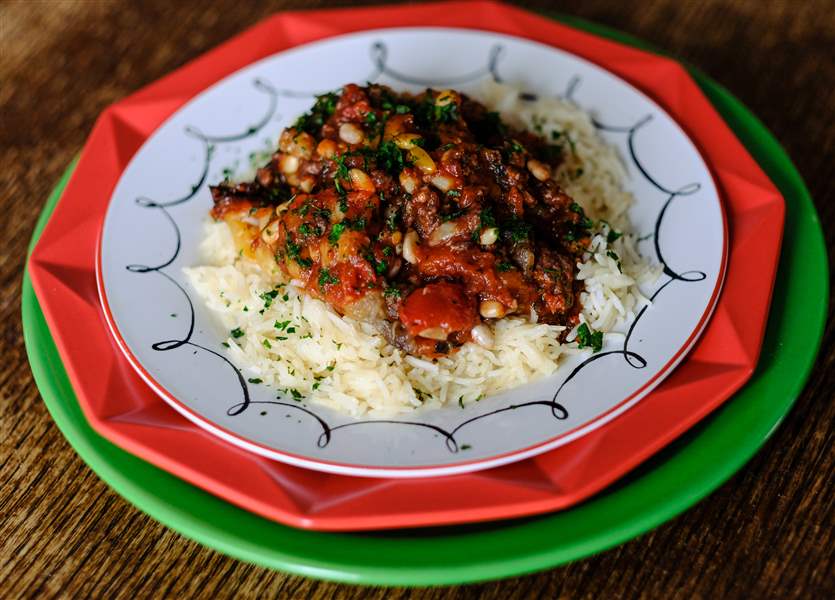
Toledo Sister Cities: Lebanon offers unique flavor
2/12/2018
Sheik el Mishee (Meat-stuffed Eggplant) is a dish from the Beqaa Valley in Lebanon.
THE BLADE/JEREMY WADSWORTH
Buy This Image
Genevieve Geha-Kirkbride enjoys both cooking and sharing Lebanese food, especially her own family’s favorite recipes.
“It’s something I love. It’s a great passion,” she said.
She was born in Zahle, Lebanon, the capital of the Beqaa Valley region, and came here when she was 6, she said. Mrs. Geha-Kirkbride is the Toledo Sister Cities International trustee for the Beqaa Valley, having been active in the organization since 1999, when a formal relationship was signed between the two areas.
Yehia “John” Shousher was instrumental in making overtures and helping to create this Sister City bond, said Labib Hajjar, owner of The Beirut restaurant. “He wanted to do good for both the Beqaa Valley and Toledo.”
Mrs. Geha-Kirkbride and U.S. Rep. Marcy Kaptur joined Mr. Shousher in establishing ties with the region.
The Beqaa Valley is an area 10 miles wide and 80 miles long situated between the Mount Lebanon and Anti-Lebanon mountain ranges in central Lebanon. Mr. Hajjar, who was born there in the town of Mashgara, said, “We have four seasons ... exactly like it is [in northwest Ohio], including a lot of snow.”
The region is therefore agricultural, “good for wheat growing” and “all kinds of fruit,” said Mr. Hajjar. His own family had a few apple trees; apricots, cherries, grapes, figs, citrus, and olives are also prevalent. Pickling and preserving are popular so that the produce can be eaten in the winter, he said.
Eating seasonally is integral to the cuisine and culture. The “farm-to-table concept is so real there,” said Nadine Hariri, whose family owns the Middle East Market and Sidon Lebanese Grille and Bakery, run by her husband Bahaa and father-in-law Mahmoud. Her maternal grandparents, Jamal and Mahassen Shaheen, split their time between Findlay and the Beqaa Valley where they’re from. Bahaa’s brother, Imad Hariri, M.D., works with Mrs. Geha-Kirkbride on the Sister City committee.
The area is noted for “mostly grains, legumes, vegetables,” Mr. Hajjar said, as well as “a lot of dairy,” such as “cheeses and labne.” Fish is not a significant part of the cuisine, as the Beqaa Valley is not a coastal region. Meat is eaten sparingly, he said, with sheep and cows being raised primarily for wool and leather.
A dish such as Kibbie bi Saniyi, then, which features lamb predominantly, is distinctive: It is a mix of meat, bulgur wheat, pine nuts, and spices that is “baked in a casserole, not fried,” said Mrs. Geha-Kirkbride. She noted that her birthplace, Zahle, is where the dish originated.
“Most areas make kibbie in the fried sort of football shape,” said Mrs. Hariri. But the Beqaa Valley has its own version that is cut into diamonds or squares for serving.
French influence on the cuisine remains in Lebanon, given France’s presence in the country from World War I until 1946.
“Generations grew up with it,” said Mrs. Geha-Kirkbride.
This is notable in pastries and desserts, such as crème caramel: a luscious custard baked in a syrup. Her family’s version contains a hint of lemon rind to cut the sweetness and to brighten the flavor.
Mrs. Hariri said that “food is culture. It brings people together” as they share a meal.
Mrs. Geha-Kirkbride, too, believes firmly in the power of food — especially considering the political turmoil and civil war that have occurred in Lebanon — to help form bonds and create community.
“If you sit and eat together,” she said, “you won’t fight.”
Sheik el Mishee (Meat-stuffed Eggplant)
“This is one of my favorite dishes,” said Genevieve Geha-Kirkbride of this family recipe that showcases vegetables with a small portion of meat.
EGGPLANT:
1 medium eggplant (see note)
1 tablespoon salt
Oil (coconut or olive)
MEAT:
½ pound lean ground lamb or beef
½ teaspoon cinnamon
1 teaspoon allspice
1 teaspoon salt
1 teaspoon pepper
½ cup toasted pine nuts
SAUCE:
1 14.5- ounce can whole plum tomatoes, chopped
1 15-ounce can tomato sauce
FOR SERVING:
Prepared rice
Preheat oven to 350F. Grease an 8-inch square casserole.
Prepare the eggplant: Trim the ends from the eggplant and cut into 1/2-inch-thick slices (across the eggplant or lengthwise). Sprinkle with salt, let sit 30 minutes. Dry off excess moisture.
Heat the oil in a large skillet over medium heat. Add the eggplant slices and brown them briefly on each side.
Prepare the meat: Brown the meat in a medium skillet, then pour off fat. Add the spices to the meat, then let cool slightly. Stir in the nuts.
Prepare the sauce: Combine the tomatoes and the tomato sauce.
Assemble the dish: Arrange a layer of eggplant, then top this with 1/3 of the meat mixture and 1/3 of the tomato sauce. Repeat the layers two more times, topping the dish with the tomato mixture.
Cover the dish with foil and bake for 30 minutes. Remove foil and bake another 20 minutes, until bubbly.
Serve over rice.
Note: Mrs. Geha-Kirkbride likes to use several skinny Japanese eggplant rather than the larger, rounder one.
Yield: 6 servings
Source: Adapted from Genevieve Geha-Kirkbride
Contact Mary Bilyeu at 419-724-6155 or mbilyeu@theblade.com, and follow her at facebook.com/thebladefoodpage.